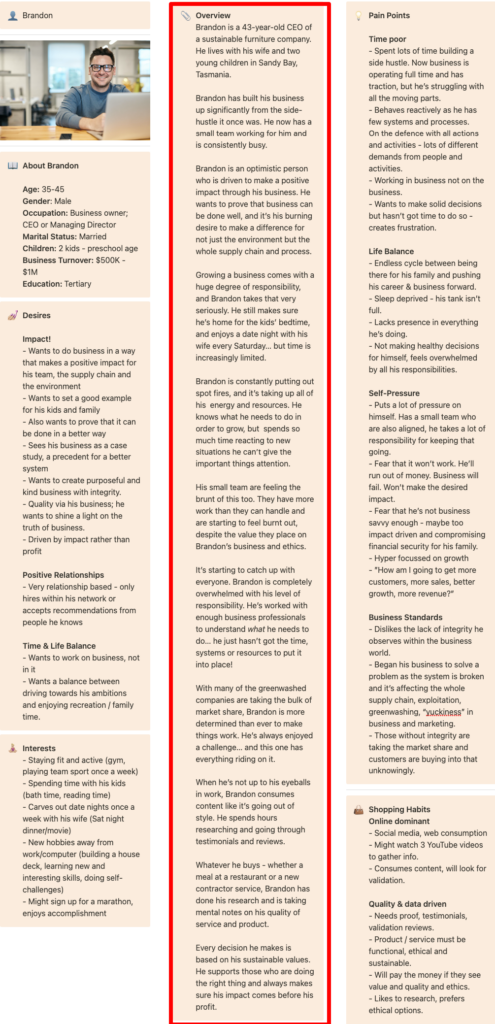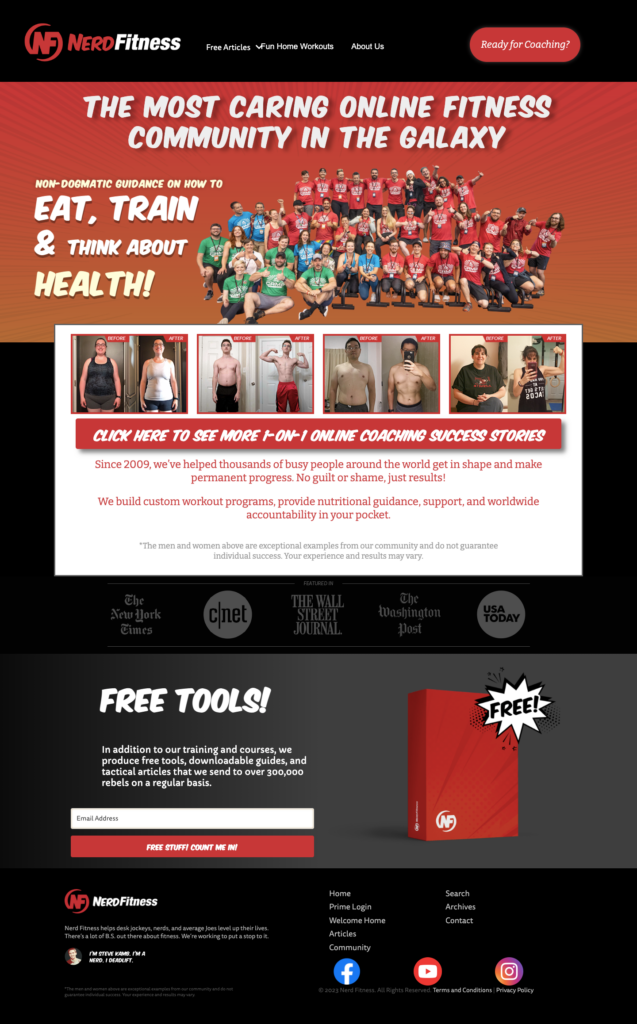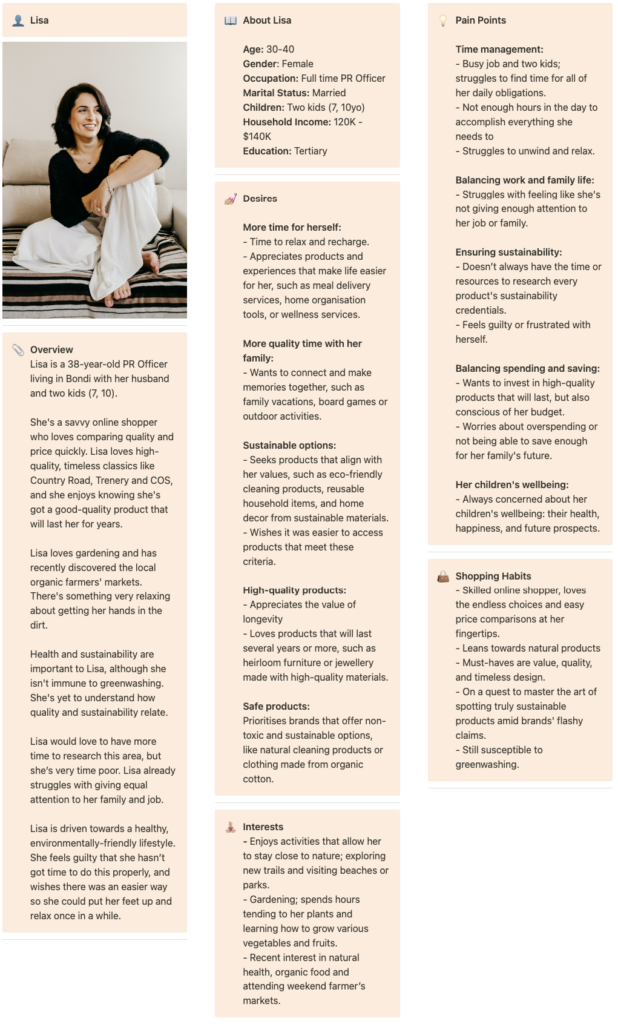Crafting a Persona Profile that Drives Impact: A 4-Step Framework
The world of marketing is ever-evolving. Yet despite changing technology and global economics, one thing remains consistent: your customers are human.
In an era when AI is looking to take over many roles, the people who interact with your business are far from robotic. They make decisions based on emotions as well as logic, and their loyalty can make or break your success.
According to Forbes, companies who put the customer at the forefront of their digital marketing will benefit financially. Specifically, businesses “with a customer experience mindset” enjoy revenue that’s 4-8% higher than the rest of their industries, while “73% of companies with above-average customer experience perform better financially than their competitors.”
Most established businesses recognise that the customer experience comes first. Many have already completed basic branding protocol that identifies their ideal client.
Some have worked with marketing agencies to more accurately profile these potential customers.
But what happens next?
It’s all too common to tick the boxes and then set your persona profile aside to gather dust.
With a business to run and a million other pressing tasks, it’s easy to see how a customer persona isn’t prioritised and integrated into a business’ marketing.
The thing is, if you’ve not integrated your persona into your business, your marketing becomes incohesive. It’s not aligned to the customer and you end up with disjointed communication.
Your email campaigns will use different language to your website, your social media and your content marketing.
You’ll end up wasting time and resources on campaigns with poor returns.
Money is poured into advertising and content creation that doesn’t connect with your clients, leaving you with possible knee-jerk reactions that waste even more time.
This article is designed to show you how to best utilise your persona profile so that it works for you, saving you time and building your revenue.
You’ll see how a well-used buyer persona can transform the success of business, and how to develop your persona profile with the use of a simple framework.
What is a Persona Profile?
A persona profile is a snapshot of your ideal customer — a real, live human being. This is also known as a customer persona, a customer avatar, or a buyer persona; they’re all the same.
The person represented in your persona profile is based on a combination of data, research and a dash of business instinct and psychology.
When you started your business, you likely sourced data and research for your marketing mix: Product/Service, Place, Price and Promotion.
Persona profile marketing takes this one step further, putting you into the customer’s shoes so you can market directly and effectively to them.
A persona is more than just a list of age, location, and buying behaviours. Anyone can create that! What you want to do is reach the heart of your customer, so they relate to you emotionally and authentically.
Developing a profile doesn’t mean you’re eliminating the rest of your market. Rather, you’re honing in on the people who are most likely to resonate with your product or service.
It’s like creating a gaming avatar. You’ll have the basic ideas already laid out within the confines of your game (business segment), and then you get to build a personality with individual likes, dislikes, behaviours and desires.
Have a look at this example of KindMark’s persona profile, and note how “Brandon” is portrayed beyond a simple desire to improve his SEO.

3 Benefits of Persona Profiles
Creating a persona profile enables you to craft content that resonates with your target audience.
By using language and images that speak to their unique personality, desires, and concerns, you establish trust and respect through various marketing channels such as email, advertising, social media, website, and blogs.
This approach helps to foster customer loyalty, generates word-of-mouth referrals, and ultimately improves your bottom line without having to constantly prove your worth.
If you’re on the fence about persona profiling, I’m hopeful the three benefits listed below will give you that final push to put one together for your business.
Benefit #1 – Buyer Personas Lead Your Product and Service Development
The most effective companies are those who aim to know their customer better than the customer knows themselves.
Before you create a new product or launch a new service, reverse-engineer what your personal profile deeply desires. This is what is truly meant by “the customer comes first.”
Julie Mathers created Flora & Fauna in 2014. What began as a side hustle grew into a large, multi-award-winning business. Julie herself was named Number 1 in “Top 50 People in Australian eCommerce” (2019) and Business Person of the Year (2018).
How did she do it?
In this interview, Julie explains that she focused on her authentic customers. No influencers, but rather a vision to build a community of like-minded shoppers who shared her purpose, values and vision.
While plenty of other retailers stocked the same product lines, Julie built an online empire around people who wanted exactly what Flora & Fauna was offering: environmentally-friendly, cruelty-free products.
Flora & Fauna was sold for approximately $30M in 2021, a testament to the growth that is possible when your business aligns with the values and ethics of your customers.
Another great example of this is seen in Nerd Fitness, an online fitness coaching business. Their name alone speaks to the people they’re targeting!

Notice how their home page is for a specific type of person with a very defined set of interests.
Ten out of ten for their “galaxy” reference – anyone who lands on this will automatically associate with Star Wars, Douglas Adams and other sci-fi/fantasy creations.
Their testimonials show clients who fit the stereotype, and their company byline proves that the founder and team at Nerd Fitness belong within the community they’re supporting.
Steve Kamb, the founder of Nerd Fitness, explains in this article that his success comes down to giving his customers what they want and making them happy. Steve hasn’t spent a single dollar on internet marketing! Instead, he’s one hundred per cent focused on the customer experience… and that means he and his team know their persona profile inside-out.
Steve is said to have a net worth of $5M. He’s proof that making your customer central to business is an essential endeavour.
Benefit #2 – Put Your Team on The Same Page
Your entire team needs to understand who the persona is and how to relate to them.
Much of Flora & Fauna’s growth came from knowing their customer base as well as they knew their own brand and goals.
In this interview, Julie explains that a key part of Flora & Fauna’s success was that her entire team was on board with their brand, purpose and values.
Flora & Fauna’s social media frequently features Julie, her family and team members. It’s a clever way of building a direct relationship with their target community, while also demonstrating how every team member embraces the philosophy and persona of the business.
Every interaction you have with your potential customers should reflect your buyer profile.
Every design decision and word choice should have your persona at the forefront of your mind, as though you’re talking to them directly.
This includes web design, SEO, copy, choice of images, how testimonials are curated… everything!
So, everyone involved in your business should know who the persona profile is: your designer, copywriter, marketing team and receptionist.
Nerd Fitness shows that not only do the staff understand the persona profile… they embody it!
This is a very deliberate and effective way of connecting with their target audience using the persona profile.

Nerd Fitness also have articles with the same theme. Check out their Star Wars Workout! While it might appear gimmicky, this consistency in communication is what has built a community of “50,000+ satisfied customers.”
Benefit #3 – Focussed Marketing Helps to Reduce Costs
Because your communication is focussed on a niche market — your persona profile — it’s easier to build loyalty, reduce your marketing spend and increase your profit.
The use of persona profiles can mean better leads, more online engagement and higher rates of organic search traffic.
According to Hubspot, buyer personas:
- Make websites up to 5 times more effective and easier to use by the targeted market
- Improve email click-through rates by 14% (that’s huge!)
- Improve conversion rates by 10%
- Can drive 18% more revenue than broadcast emails
That’s just for websites and emails — consider other types of communication.
What type of marketing does your persona consume? Are they social media savvy or do they prefer exclusive print magazines?
Would a pay-per-click ad be effective for your persona?
A spontaneous type persona might click on an advertisement that leads to sales page, while a more cautious shopper would prefer a landing page that provides more information.
With a well-defined persona profile, you can focus these campaigns and minimise wasted costs.
Customers are the reason your business succeeds, so focusing on them ensures you’re building your venture while reducing your marketing costs.
How to Create a Persona Profile in 4 Easy Steps
This is a simple outline of how to create your own detailed persona profile.
There are plenty of templates available online to help with this process. That said, this is really a matter of filling in the blanks for each question. You can deal with templates later — the information comes first.
Step 1: Brainstorm and Data Collection
A persona profile isn’t a figment of your imagination — it’s based on solid data and statistics with a sprinkle of creative license.
Hidden away in a dusty e-storage cupboard (from the last time you looked at your client persona), is a collection of human-driven data about your customer.
Now is the perfect time to review that information and its relevance.
Now is also a great opportunity to engage your existing customers. You could send out a survey, talk to your clients face-to-face, or take a deep dive into your testimonials or product reviews.
Getting first-hand information from your customers helps you to develop your persona profile more accurately.
Demographics
This is an overview of your client and their life circumstances.
A single mother with two young kids, working part-time, will have very different needs to a married man with a stay-at-home wife and a high-rolling career.
This section of your persona defines their needs.
- Age range
- A ten-year range is good (E.g. 30-40 years old)
- Income bracket
- Household income for B2C
- Annual turnover for B2B
- A range of $100K is good (E.g. $100K – $200K)
- Work circumstances
- Full-time, part-time, casual, stay-at-home parent
- Business owner, employee, board member etc.
- Work role (admin, CEO, retail, P.A etc.)
- Living circumstances
- Suburb
- House or unit?
- What are the indicators of their lifestyle? (A boat, an investment property, private school for kids etc.)
- Married? Single? Divorced? Widowed?
Behaviour
Your ideal client’s behaviour will affect the way they source and engage your business.
For instance, an elderly pensioner isn’t going to do a Google search for your therapeutic tea business. But a tech-savvy 40-year-old might seek alternative health support online.
- Drive: Positive (gravitates towards a desired outcome) or negative (avoids an undesirable outcome)?
- Decision making: Spontaneous, cautious, well-researched?
- Values: Convenience, cost or quality?
- Learning style: visual, auditory, kinaesthetic?
- Consider how you’ll convey information to this type of person.
Psychographics
This is where you fill out the finer details of your persona profile and flesh them out into a real person.
Think outside the scope of your own business — your product or service might not be on this person’s radar yet. Choose your answers based on their actual life, not how they relate to your business directly.
- Who and what do they care about?
- What are they passionate about?
- What makes them angry?
- What kind of language do they use?
- What frustrations or challenges do they face daily?
- What do they really want for their life?
Remember that your client is a whole person. When you relate to them on this level, your marketing becomes more accessible.
Steve Kamb talks about this directly on the Nerd Fitness website. He explains, “In 2008, I purchased the domain NerdFitness.com because I didn’t see anybody helping out people like me: people with desk jobs that love nerd culture, games, books, and movies, but also know they need to make healthier choices in their day to day lives.”
Detailed psychographics help you to join the dots for your client before they do. In this way, they sense your business understands them on a deeper level.
It’s not a transactional relationship — it’s a mutually beneficial relationship based on trust and loyalty.
Step 2 – Organise Your Data
Once you’ve gathered all the information you need, it’s time to organise it. In this way, you’ll have the outline of your persona profile at a glance.
This doesn’t need to be paragraphs of text — simple subheadings and bullet points will work.
At KindMark, we’ve co-developed a template that now lives in every client portal. It contains all of the basic information plus a section for more detailed responses.
Have a look at our template below for Lisa; persona for a business selling organic bedding and clothing.
Note the way it’s organised: you can easily see Lisa’s desires, pain points, interests and behaviours with a quick scan.
This breakdown allows us to view Lisa as someone who engages with that business within the context of her personality and life. The products she buys are reflective of her desires as a person, not her desires for a material object.

Step 3: Write Your Persona
Your persona is a succinct overview of the summarised points from the data you’ve collected.
The “overview” section is where the avatar comes to life. Keep it concise, with enough information to make them “real”.
At this stage, your persona profile has little to do with your own business — it’s all about the customer.
In our overview above, each aspect of Lisa’s desires, interests, pain points and shopping habits are referenced, and yet that section is still only five short paragraphs.
Often it helps to write a story about your persona. Create a full description of their life and daily experiences.
Then, edit out the fluff so your overview gives a more concise description of your customer. This process will help clarify who your persona is, even if you don’t end up using everything you wrote out.
A persona profile generator might be an easy or time-saving option, but bear in mind that some of the tools available will create fairly generic copy.
It’s worth investing a little time and energy in getting your customer avatar right, as the content of all your digital communications will be based on this.
Step 4: Design Your Persona Profile
Now that have your persona copy written, it’s time to bring them to life in a document that everyone in your team can reference.
I recommend you keep this document to one or two pages maximum. Who’s got time to go through a ten-page slide deck anyway?
You want this profile to be used and cited regularly. If it’s too big or ambiguous, it’s going to get buried in the too-hard folder, never to be seen again.
It helps to add a portrait image of your persona to remind you that you’re speaking to a human.
A persona profile template is a document that contains key headings, and you fill the spaces in with your research and imagination.
KindMark has developed a simple persona template using Notion that lives in each client portal as part of the SEO Toolkit.
Take your pick with how you want to present your profile.
Some options include:
- A simple document like this Google doc template
- A Canva template (watch the length on this one)
- Professional design via sites such as 99 Designs or UpWork
Best Practices To Maximise Your Buyer Persona
Be The Persona Champion in Your Team
Someone needs to wave the flag for your persona and regularly remind the team who they’re communicating with.
When you live and breathe your ideal customer, they become part of your daily activities.
For every meeting, blog, social media post or ad, remember to ask, “What would [PERSONA NAME] want?”
Whether you’re posting on Instagram, developing a new product or online course, or writing a newsletter, remind your team to put the persona first.
Use their name, talk about them like they’re the only customer you have. Keep them real and relevant, so you reap the benefits of your targeted marketing.
Put Your Profile Front and Centre
As a practical and visual reminder for your team, make your persona profile a prominent feature of the workplace.
Print it out as a poster and pin it on your studio wall.
Link the persona within the main navigation of your project management tool.
Include the persona in presentations and proposals.
By keeping the persona front-of-mind, you’re ensuring its effective use and relevance to your daily operations.
Revisit Your Profile Regularly
As your business evolves, you’ll find that your ideal client changes. Revisiting your avatar means that your marketing will always be on point.
A well-established business might only need to fine-tune their persona, to ensure they’re on track.
A startup business might want to review its persona more frequently, as its real customer base develops.
You can change your persona profile where necessary, and I recommend that you revisit it every 6-12 months.
Final Thoughts on Persona Profiles
Creating a persona profile might feel like a lot of work, especially when there are so many other demands on your time.
Remember, there are significant benefits to investing your energy into this process.
A well-developed buyer persona can lead to increased customer loyalty, higher revenue and reduced marketing costs.
You’ll develop a better understanding of your customers, and in the long run, you’ll transform your business success.
It’s well worth the effort, and you may even come up with product, service or marketing initiatives throughout the process.

